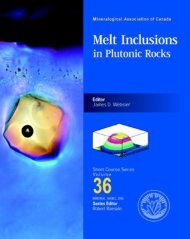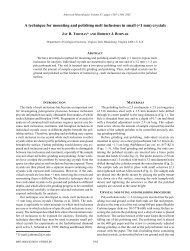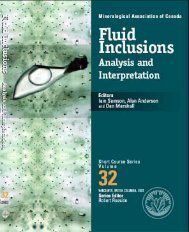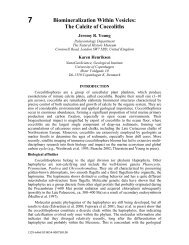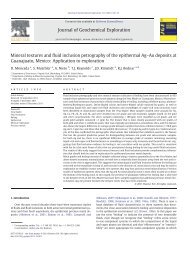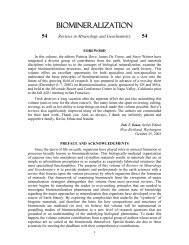Laser Ablation–ICP–MS in the Earth Sciences ... - Virginia Tech
Laser Ablation–ICP–MS in the Earth Sciences ... - Virginia Tech
Laser Ablation–ICP–MS in the Earth Sciences ... - Virginia Tech
You also want an ePaper? Increase the reach of your titles
YUMPU automatically turns print PDFs into web optimized ePapers that Google loves.
AMS uses <strong>the</strong> LA–ICP–MS signal from <strong>the</strong> FI<br />
(Fig. A5-4, box 4) and a known external standard<br />
(e.g., NIST 610) to calculate elemental concentration<br />
ratios (Fig. A5-4, box 5). AMS uses <strong>the</strong><br />
<strong>in</strong>tegrated signal areas after background subtraction<br />
for <strong>the</strong> FI and standard to determ<strong>in</strong>e elemental<br />
<strong>in</strong>tensity ratios us<strong>in</strong>g equation (1) (from (Longerich<br />
et al. 1996). The use of an external standard<br />
elim<strong>in</strong>ates <strong>the</strong> effects of element-specific <strong>in</strong>strumental<br />
sensitivity (Longerich et al. 1996).<br />
C<br />
C<br />
Sample<br />
Ca<br />
Sample<br />
Na<br />
C<br />
C<br />
S tan d<br />
Ca<br />
S tan d<br />
Na<br />
I<br />
×<br />
I<br />
Sample<br />
Ca<br />
Sample<br />
Na<br />
ANALYSIS MANAGEMENT SYSTEM (AMS)<br />
× I<br />
× I<br />
S tan d<br />
Na<br />
S tan d<br />
Ca<br />
= (1)<br />
The absolute concentrations of <strong>in</strong>dividual elements<br />
<strong>in</strong> <strong>the</strong> <strong>in</strong>clusion are determ<strong>in</strong>ed from <strong>the</strong> calculated<br />
element ratios and <strong>the</strong> bulk sal<strong>in</strong>ity obta<strong>in</strong>ed by<br />
micro<strong>the</strong>rmometry us<strong>in</strong>g mass balance constra<strong>in</strong>ts<br />
(He<strong>in</strong>rich et al. 2003) (Fig. A5-4, box 7), with or<br />
without a drift correction (Fig. A5-4, box 6).<br />
After <strong>the</strong> laser ablation ICP–MS spectra have<br />
been collected, one launches <strong>the</strong> options w<strong>in</strong>dow <strong>in</strong><br />
AMS (Fig. A5-5) to def<strong>in</strong>e <strong>the</strong> parameters used<br />
321<br />
dur<strong>in</strong>g <strong>the</strong> analysis, <strong>in</strong>clud<strong>in</strong>g which standards were<br />
used, how many standard analyses were conducted,<br />
and <strong>the</strong> method that will be used to calculate<br />
concentrations. In <strong>the</strong> example shown <strong>in</strong> Figure<br />
A5-5, four analyses of NIST 610 (two at <strong>the</strong><br />
beg<strong>in</strong>n<strong>in</strong>g of <strong>the</strong> session and two at <strong>the</strong> end) were<br />
used for <strong>the</strong> external standards. Dur<strong>in</strong>g micro<strong>the</strong>rmometry,<br />
<strong>the</strong> ice phase melted at –18ºC, and<br />
this value is entered <strong>in</strong> <strong>the</strong> “Method” section and<br />
used to calculate <strong>the</strong> bulk sal<strong>in</strong>ity. The host<br />
correction options shown <strong>in</strong> <strong>the</strong> lower left are not<br />
required for this fluid <strong>in</strong>clusion analysis because <strong>the</strong><br />
host is quartz and we did not measure Si <strong>in</strong> <strong>the</strong> FI.<br />
The <strong>in</strong>strument sett<strong>in</strong>gs used dur<strong>in</strong>g <strong>the</strong> analysis<br />
<strong>in</strong>cluded concentrations <strong>in</strong> counts, with a dwell time<br />
of 0.01 sec and drift correction confidence <strong>in</strong>terval<br />
(R 2 ) of 0.9. In this example, <strong>the</strong> “Generate<br />
fractionation plots” option was not selected. At <strong>the</strong><br />
conclusion of <strong>the</strong> data reduction process, <strong>the</strong> results<br />
w<strong>in</strong>dow (see below) will be shown and <strong>the</strong> results<br />
will be written to an Excel file, as def<strong>in</strong>ed by <strong>the</strong><br />
output options.<br />
Once all <strong>the</strong> options have been set, <strong>the</strong> ICP–MS<br />
FIG. A5-5. Options W<strong>in</strong>dow to def<strong>in</strong>e <strong>the</strong> conditions that were used dur<strong>in</strong>g data collection and methods to be used for data<br />
reduction <strong>in</strong> AMS.



